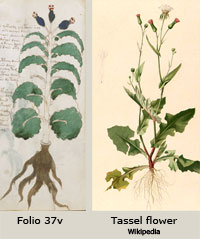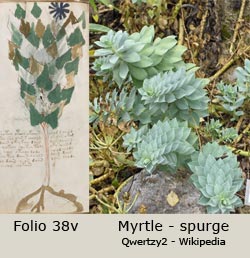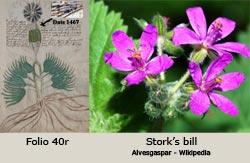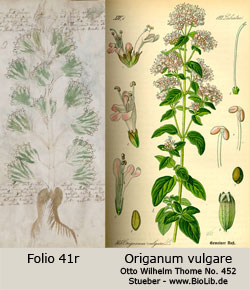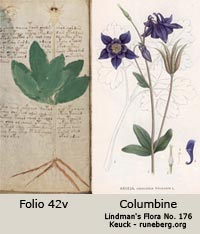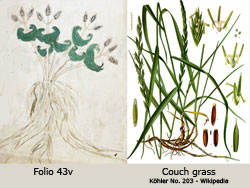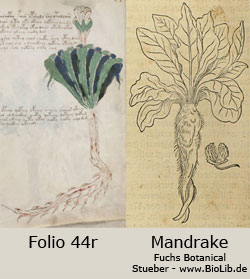The Voynich Botanical Plants
Folio 37v, Tassel flower (Emilia fosbergii), is probably native to Africa and Asia. It is an annual herb with a branched taproot and large, ovate, toothed lower leaves and smaller, alternate upper leavers that clasp the weakly erect stem. The stem terminates in purple, scarlet, red, pink, orange, or white thistle-like flowers. The young leaves are eaten and the seeds are used as a cereal.
Folio 38v, Myrtle Spurge or Donkey tail (Euphorbia myrsinites), is a fleshy herbaceous plant, a native of Southeastern Europe. The blueish-green leaves are spirally arranged around the sprawling stem. Inconspicuous yellow (not blue) flowers in yellow bracts are produced in the Spring. Handling this plant may cause a skin irritation or an allergic reaction.
Folio 40r, Stork’s bill (Erodium malacoides), is a member of the geranium family found in the Mediterranean region. The leaves are deeply lobed and the loose clusters of blue, pink, or white flowers have five petals with purplish veins. An infusion made from the root of this plant was used as mouth wash or to sooth a throat infection.
Folio 40v, Crocus (Crocus vernus), is native to central and southern Europe. It grows from corms, the leaves are grass-like in appearance, and the cone-shaped flowers occur in white, yellow, blue, and purple. The blue crocus, (Crocus sativus), blooms in the autumn and the spice saffron is obtained from its stigmas. Tuscany is one of the places used for saffron production and it was commonly used to flavor foods eaten by wealthy medieval households.
Folio 41r, Wild Marjoram (Origanum vulgare), is a Mediterranean herb that is widely used in Greek and Italian cuisines. It has creeping roots that send up woody stems with opposite, hairy, petiolate leaves. The individual flower stalks are made up of clusters of pale purple flowers that grow upward from various points on the main stem to approximately the same height. Due to its antioxidant and antimicrobial properties, the Greeks found Marjoram useful for poultices. It was the custom for both the Greeks and Romans to crown young couples with Marjoram.
Folio 41v, Coriander or Cilantro (Coriandrum sativum), is native to Asia and North Africa. Its seeds were found in the tomb of Tutankhamun. The plant was cultivated by the Greeks in the second millennium BC and the Romans introduced the herb into Britain. Coriander has a taproot and the leaves at the base of the plant are broadly lobed becoming more feathery higher up, with umbels of white to pale pink flowers at the top of the stem. Coriander seed and leaf were very widely used in medieval cuisine.
Folio 42v, European columbine, Culverwort or Granny's nightcap (Aquilegia vulgaris), is a species of columbine native to Europe. It has a fibrous root system. A tuft of large long dark green leaves grows at the base of the plant; higher up the stem they become smaller and are grouped in leaflets of three. The slender, erect branched flower stems end in drooping purple, sometimes white, flowers whose five petals end in a hornlike spur. Columbines are a member of the Ranunculaceae family and are therefore poisonous. The flower is sacred to Venus and it was believed that carrying a posy of the flowers would arouse the affections of a loved one.
Folio 43r, Chickweed (Stellaria media), is an annual plant native to Europe. It germinates in the fall or late winter, rapidly forming large mats of foliage. The smooth, pale-green leaves are egg-shaped and the single, small, white flowers sprout from the axils of the upper leaves. The petals are narrow and deeply cleft. The fresh leaves were used to make a poultice to treat inflammation and ulcers. The seeds are eaten by chickens, hence the name chickweed.
Folio 43v, Couch grass (Elytrigia repens), is a grass common to most of Europe and Asia. It is an invasive grass due to a creeping rhizome root. The leaves are long and linear and the long flower spike has spikelets with three to eight florets. The Greeks used couch grass as a herbal remedy. In medieval times it was used to treat bladder and urinary tract infections. Sick dogs will dig up and eat the roots.
Folio 44r, Mandrake (Mandragora officinarum), is a plant from Southern Europe and around the Mediterranean Sea. It is a long-leafed, dark-green plant with greenish-yellow, bell-shaped flowers that grow on stalks to produce orange berries known as “Satan’s apples.” In the Middle Ages the people believed that the forked, parsnip-like taproot, resembling a human form, gave the plant magical powers. The aphrodisiac properties of the mandrake are referred to in Genesis. The Romans gave the root to patients during operations for an anesthetic.
